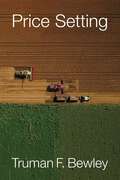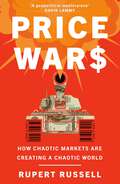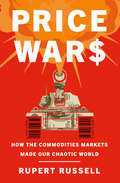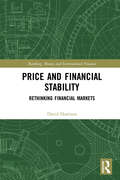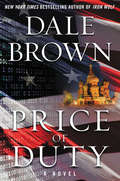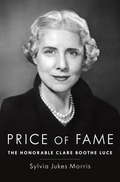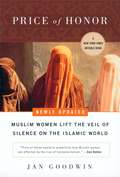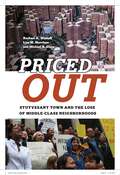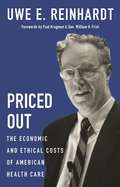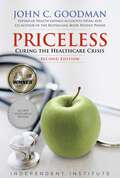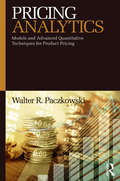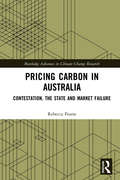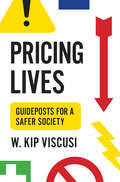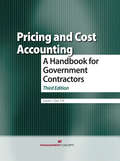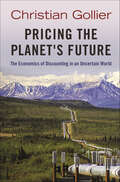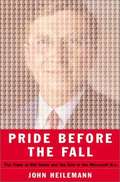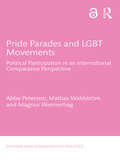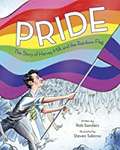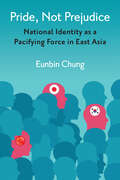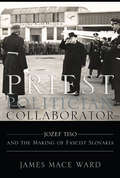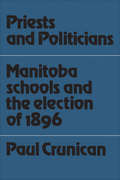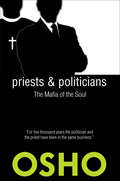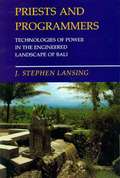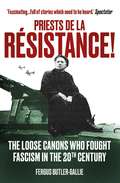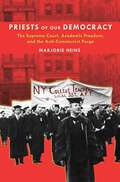- Table View
- List View
Price Setting
by Truman F. BewleyThe prices of some products fluctuate dramatically, while others remain more constant. What accounts for these extreme differences? Renowned economist Truman F. Bewley investigates and elucidates this puzzling problem. Its crux, he argues, is that differentiated product prices are usually stable, whereas the prices of undifferentiated products – for which buyers can easily find comparable substitutes – are often volatile. Although product differentiation gives producers market power, this power alone does not guarantee price stability. There are nearly undifferentiated products whose producers have market power yet for which prices are unstable. Weakness of product differentiation makes it so advantageous for producers to compete on price that they do so and forego the benefits and stability of price collusion. Producers of truly differentiated goods prefer to compete on product performance rather than price and find that reducing prices during recessions does little to increase demand. Based on hundreds of interviews with businesspeople responsible for setting prices, Bewley’s book is an unusual and groundbreaking work, with findings vital for economists, students, and policymakers.
Price Wars: How Chaotic Markets Are Creating a Chaotic World
by Rupert RussellFor Rupert Russell, the shock of the Trump-Brexit victories was only the latest in a decade full of them: the unstoppable war in Syria, huge migrant flows into Europe, beheadings in Iraq, children caged at the US border. In Price Wars he sets out on an improbable journey to investigate what caused the wave of chaos that consumed the world in the 2010s.Armed with a notebook, flak jacket and pink socks, Russell travels to modern apocalypses across five continents, embedding with separatist soldiers in the trenches of Eastern Ukraine, gangs of street kids battling over garbage in Caracas, the UN bomb disposal squad in Iraq and cattle raiders in Northern Kenya. He traces the origins of these conflicts back to dramatic and mysterious swings in the prices of essential commodities. He meets with commodity speculators who describe the inner workings of these volatile markets, explaining how food prices can spike even in years of abundant harvests, causing bread riots and revolutions. Oil prices can surge on rumours, enriching and emboldening dictators and terrorists alike. These price shocks, and many others across the decade, triggered local disasters that became global catastrophes. It is chaotic prices, Russell learned, fuelled by banks and hedge funds in New York and London, that have toppled regimes and fractured the West.Price Wars is a page-turning chronicle of discovery and a ground-breaking expose of the power of price to devastate the world.
Price Wars: How the Commodities Markets Made Our Chaotic World
by Rupert RussellA fascinating, groundbreaking exposé of how commodity traders in New York and London have destabilized societies all over the world, leaving the most vulnerable at the mercy of hunger, chaos, and war.For Rupert Russell, the Brexit vote was only the latest shock in a decade full of them: the unstoppable war in Syria, huge migrant flows into Europe, beheadings in Iraq, children placed in cages on the U.S. border. In Price Wars, he sets out on a worldwide journey to investigate what caused the wave of chaos that consumed the world in the 2010s.Russell travels to Tunisia, Iraq, Venezuela, Ukraine, East Africa, and Central America and discovers that unrest in all these places was triggered by dramatic and mysterious swings in the price of essential commodities. Deregulation of the commodities markets means that food prices can shoot up even in years of abundant harvests, causing hunger and protest. Oil prices and real-estate values can surge even when supplies are normal, enriching and emboldening dictators. It is this instability--fueled by banks and hedge funds in faraway New York and London--that has toppled regimes and unsettled the West. Price Wars is a fascinating, original, and groundbreaking exposé of the power of the commodities markets to disrupt the world.
Price and Financial Stability: Rethinking Financial Markets (Banking, Money and International Finance)
by David HarrisonWhy are financial prices so much more crisis-prone and unstable than real economy prices? Because they are doing different things. Unlike real economy prices, rooted in the real goods and services produced and exchanged, financial prices attempt to value future income flows from financial and capital assets. These valuations fluctuate erratically because expectations of the future fluctuate – and large liquid financial markets can amplify, rather than correct, these effects. The book builds on the insights of economists Frank Knight and John Maynard Keynes, that uncertainty of the future is essential to understand the processes of economic production and capital investment, and adds to this Karl Popper's general explanation of how expectations of an uncertain future are formed and tested through a trial and error process. Rather than relying on fluctuating financial prices to provide a guide to an uncertain future, it suggests a better approach would be to adopt the methods common to other branches of science, and create testable (falsifiable) theories allowing reasonable predictions to be made. In finance, the elements of one such theory could be based on the concept of forecasting yield from capital assets, which is a measurable phenomenon tending towards aggregate and long-term stability, and where there is a plentiful supply of historic data. By methods like this, financial economics could become a branch of science like any other. To buttress this approach, the widely accepted public policy objective of promoting real economy price stability could be widened to include financial price stability.
Price of Duty: A Novel (Patrick McLanahan)
by Dale BrownThe U.S. and its Western allies come under a diabolical Russian cyber warfare attack in this action-packed military techno-thriller from New York Times bestselling master Dale Brown.In a top-secret location deep in the Ural Mountains, Russian President Gennadiy Gryzlov has built his nation’s most dangerous weapon since the atomic bomb—a fearsome tool to gain superiority in Russia’s long-running battle with the West. From inside Perun Aerie—an intricate network of underground tunnels and chambers that is the heart of the Russian cyber warfare program—he is launching a carefully plotted series of attacks on an unsuspecting U.S. and its European allies. The first strike targets Warsaw, Poland, where Russian malware wipes out the records of nearly every Polish bank account, imploding the country’s financial system and panicking the rest of Europe. When Stacy Anne Barbeau, the besieged American president, fails to effectively combat the Russian threat, Brad McLanahan, on some well-earned R&R with his new Polish girlfriend, Major Nadia Rozek, is called back to duty. As the Russians’ deadly tactics escalate—including full-scale assaults on Europe’s power grid and the remote hijacking of a commercial airliner that kills hundreds of civilians—McLanahan and his Scion team kick into gear, arming themselves with the most advanced technological weaponry for the epic struggle ahead. A patriot in the mold of his father, the late general Patrick McLanahan, Brad knows firsthand the price of freedom. With the world’s fate hanging in the balance, will Scion succeed in turning back Gryzlov before he can realize his terrifying ambition to conquer the globe? And what will the toll of victory be?
Price of Fame
by Sylvia Jukes Morris"I hope I shall have ambition until the day I die," Clare Boothe Luce told her biographer Sylvia Jukes Morris. Price of Fame, the concluding volume of the life of an exceptionally brilliant polymath, chronicles Luce's progress from the early months of World War II, when, as an eye-catching Congresswoman and the only female member of the House Military Affairs Committee, she toured the Western Front, captivating generals and GIs. She even visited Buchenwald and other concentration camps within days of their liberation. After a shattering personal tragedy, she converted to Roman Catholicism, and became the first American woman to be appointed ambassador to a major foreign power. "La Luce," as the Italians called her, was also a prolific journalist and magnetic public speaker, as well as a playwright, screenwriter, pioneer scuba diver, early experimenter in psychedelic drugs, and grande dame of the GOP in the Reagan era. Tempestuously married to Henry Luce, the powerful publisher of Time Inc., she endured his infidelities while pursuing her own, and remained a practiced vamp well into old age. Price of Fame begins in January 1943 with Clare's arrival on Capitol Hill as a newly elected Republican from Connecticut. The thirty-nine-year-old beauty attracted nationwide attention in a sensational maiden speech, attacking Vice President Henry Wallace's civil aviation proposals as "globaloney." Although she irked President Franklin D. Roosevelt by slanging his New Deal as "a dictatorial Bumbledom," she impressed his wife Eleanor. Revealing liberal propensities, she lobbied for relaxed immigration policies for Chinese, Indians, and displaced European Jews, as well as equal rights for women and blacks. Following Hiroshima, the legislator whom J. William Fulbright described as "the smartest colleague I ever served with" became a passionate advocate of nuclear arms control. But in 1946, she gave up her House seat, convinced that politics was "the refuge of second-class minds." After a few seasons of proselytizing on the Catholic lecture circuit, Clare emerged as a formidable television personality, campaigning so spectacularly for the victorious Republican presidential candidate, Dwight D. Eisenhower, that he rewarded her with the Rome embassy. Ambassador Luce took an uncompromising attitude toward Italy's Communist Party, the world's second largest, and skillfully helped settle the fraught Trieste crisis between Italy and Yugoslavia. She was then stricken by a mysterious case of poisoning that the CIA kept secret, suspecting a Communist plot to assassinate her. The full story, told here for the first time, reads like a detective novel. Price of Fame goes on to record the crowded later years of the Honorable Clare Boothe Luce, during which she strengthened her friendships with Winston Churchill, Somerset Maugham, John F. Kennedy, Evelyn Waugh, Lyndon Johnson, Salvador Dalí, Richard Nixon, William F. Buckley, the composer Carlos Chávez, Ronald Reagan, and countless other celebrities who, after Henry Luce's death, visited her lavish Honolulu retreat. In 1973, she was appointed by Nixon to the President's Foreign Intelligence Advisory Board, a position she continued to hold in the Ford and Reagan administrations. Sylvia Jukes Morris is the only writer to have had complete access to Mrs. Luce's prodigious collection of public and private papers. In addition, she had unique access to her subject, whose death at eighty-four ended a life that for variety of accomplishment qualifies Clare Boothe Luce for the title of "Woman of the Century."From the Hardcover edition.
Price of Honor
by Jan GoodwinMuslim women, symbols of honour for their men, speakout and take us into the volatile heartland of Islam, theworld's fastest growing religion. Price of Honour recounts awide range of telling, often horrific stories about the ways in whichMuslim women are abused and oppressed by their menfolk, and shows howrestrictions on women act as a barometer for measuring both the growthof fundamentalism and the Muslim regimes' willingness to appeaseextremists.
Priced Out: Stuyvesant Town and the Loss of Middle-Class Neighborhoods
by Lisa M. Morrison Michael R. Glass Rachael A. WoldoffOn an average morning in the tree-lined parks, plazas, and play-areas of Manhattan’s Stuyvesant Town housing development, birds chirp as early risers dash off to work, elderly residents enjoy a peaceful morning stroll, and flocks of parents usher their children to school. It seems an unlikely location for conflict and strife, yet this eighteen-block area, initially planned as middle-class affordable housing, is the site of an ongoing struggle between long-term, rent-regulated residents, younger, market-rate tenants, and new owners seeking to turn this community into a luxury commodity. Priced Out takes readers into this heated battle as a transitioning neighborhood wrestles with contemporary capitalist strategies and the struggle to preserve renters’ rights. Since the early 2000’s, Stuyvesant Town’s owners have sought to transform this iconic Manhattan housing development into a luxury destination for those able to afford the higher price tag. Attempting to replace longtime residents with younger, more affluent tenants, they have disrupted native residents’ sense of place, community, and their perceived quality of life. Through resident interviews, the authors offer an intimate view into the lives of different groups of tenants involved in this struggle for prime real estate in New York, from students experiencing the city for the first time to baby boomers hanging on to the vestiges of middle-class urban life. A compelling, fascinating account of changing urban landscapes and the struggle for security, Priced Out offers a comprehensive perspective of a community that, to some, is becoming unrecognizable as it is upgraded and altered.
Priced Out: The Economic and Ethical Costs of American Health Care
by Uwe E. ReinhardtFrom a giant of health care policy, an engaging and enlightening account of why American health care is so expensive—and why it doesn't have to beUwe Reinhardt was a towering figure and moral conscience of health care policy in the United States and beyond. Famously bipartisan, he advised presidents and Congress on health reform and originated central features of the Affordable Care Act. In Priced Out, Reinhardt offers an engaging and enlightening account of today's U.S. health care system, explaining why it costs so much more and delivers so much less than the systems of every other advanced country, why this situation is morally indefensible, and how we might improve it.The problem, Reinhardt says, is not one of economics but of social ethics. There is no American political consensus on a fundamental question other countries settled long ago: to what extent should we be our brothers' and sisters' keepers when it comes to health care? Drawing on the best evidence, he guides readers through the chaotic, secretive, and inefficient way America finances health care, and he offers a penetrating ethical analysis of recent reform proposals. At this point, he argues, the United States appears to have three stark choices: the government can make the rich help pay for the health care of the poor, ration care by income, or control costs. Reinhardt proposes an alternative path: that by age 26 all Americans must choose either to join an insurance arrangement with community-rated premiums, or take a chance on being uninsured or relying on a health insurance market that charges premiums based on health status.An incisive look at the American health care system, Priced Out dispels the confusion, ignorance, myths, and misinformation that hinder effective reform.
Priceless: Curing the Healthcare Crisis
by John C. GoodmanIn this long-awaited updated edition of his groundbreaking work Priceless: Curing the Healthcare Crisis, renowned healthcare economist John Goodman ("father" of Health Savings Accounts) analyzes America&’s ongoing healthcare fiasco—including, for this edition, the failed promises of Obamacare.Goodman then provides what many critics of our healthcare system neglect: solutions. And not a moment too soon. Americans are entangled in a system with perverse incentives that raise costs, reduce quality, and make care less accessible. It&’s not just patients that need liberation from this labyrinth of confusion—it&’s doctors, businessmen, and institutions as well. Read this new work and discover: why no one sees a real price for anything: no patient, no doctor, no employer, no employee; how Obamacare&’s perverse incentives cause insurance companies to seek to attract the healthy and avoid the sick; why having a preexisting condition is actually WORSE under Obamacare than it was before—despite rosy political promises to the contrary; why emergency-room traffic and long waits for care have actually increased under Obamacare; how Medicaid expansion spends new money insuring healthy, single adults, while doing nothing for the developmentally disabled who languish on waiting lists and children who aren&’t getting the pediatric care they need; how the market for medical care COULD be as efficient and consumer-friendly as the market for cell phone repair... and what it would take to make that happen; how to create centers of medical excellence, which compete to meet the needs of the chronically ill; and much, much more... Thoroughly researched, clearly written, and decidedly humane in its concern for the health of all Americans, John Goodman has written the healthcare book to read to understand today&’s healthcare crisis. His proposed solutions are bold, crucial, and most importantly, caring. Healthcare is complex. But this book isn&’t. It&’s clear, it&’s satisfying, and it&’s refreshingly human. If you read even one book about healthcare policy in America, this is the one to read.
Pricing Analytics: Models and Advanced Quantitative Techniques for Product Pricing
by Walter R. PaczkowskiThe theme of this book is simple. The price – the number someone puts on a product to help consumers decide to buy that product – comes from data. Specifically, itcomes from statistically modeling the data. This book gives the reader the statistical modeling tools needed to get the number to put on a product. But statistical modeling is not done in a vacuum. Economic and statistical principles and theory conjointly provide the background and framework for the models. Therefore, this book emphasizes two interlocking components of modeling: economic theory and statistical principles. The economic theory component is sufficient to provide understanding of the basic principles for pricing, especially about elasticities, which measure the effects of pricing on key business metrics. Elasticity estimation is the goal of statistical modeling, so attention is paid to the concept and implications of elasticities. The statistical modeling component is advanced and detailed covering choice (conjoint, discrete choice, MaxDiff) and sales data modeling. Experimental design principles, model estimation approaches, and analysis methods are discussed and developed for choice models. Regression fundamentals have been developed for sales model specification and estimation and expanded for latent class analysis.
Pricing Carbon in Australia: Contestation, the State and Market Failure (Routledge Advances in Climate Change Research)
by Rebecca PearseIn the mid-2000s it seemed that the global carbon market would take off and spark the worldwide transition to a profitable low carbon economy. A decade on, the experiment in carbon trading is failing. Carbon market schemes have been plagued by problems and resistance to carbon pricing has come from the political Left and Right. In the Australian case, a national emissions trading scheme (ETS) was dismantled after a long, bitter public debate. The replacement ‘Direct Action Plan’ is also in disrepute. Pricing Carbon in Australia examines the rise and fall of the ETS in Australia between 2007 and 2015, exploring the underlying contradictions of marketised climate policy in detail. Through this and other international examples, the book offers a critique of the political economy of marketised climate policy, exploring why the hopes for global carbon trading have been dashed. The Australian case is interpreted in light of a broader legitimation crisis as state strategies for (temporarily) displacing the climate crisis continue to fail. Importantly, in the wake of carbon market failure, alternative agendas for state action are emerging as campaigns for the retrenchment of fossil fuel assets and for just renewable energy transition continue transforming climate politics and policy as we know it. This book is a valuable resource for practitioners and academics in the fields of environmental policy and politics and social movement studies.
Pricing Lives: Guideposts for a Safer Society
by W. ViscusiHow society’s undervaluing of life puts all of us at risk—and the groundbreaking economic measure that can fix itLike it or not, sometimes we need to put a monetary value on people's lives. In the past, government agencies used the financial "cost of death" to monetize the mortality risks of regulatory policies, but this method vastly undervalued life. Pricing Lives tells the story of how the government came to adopt an altogether different approach--the value of a statistical life, or VSL—and persuasively shows how its more widespread use could create a safer and more equitable society for everyone.In the 1980s, W. Kip Viscusi used the method to demonstrate that the benefits of requiring businesses to label hazardous chemicals immensely outweighed the costs. VSL is the risk-reward trade-off that people make about their health when considering risky job choices. With it, Viscusi calculated how much more money workers would demand to take on hazardous jobs, boosting calculated benefits by an order of magnitude. His current estimate of the value of a statistical life is $10 million. In this book, Viscusi provides a comprehensive look at all aspects of economic and policy efforts to price lives, including controversial topics such as whether older people's lives are worth less and richer people's lives are worth more. He explains why corporations need to abandon the misguided cost-of-death approach, how the courts can profit from increased application of VSL in assessing liability and setting damages, and how other countries consistently undervalue risks to life.Pricing Lives proposes sensible economic guideposts to foster more protective policies and greater levels of safety in the United States and throughout the world.
Pricing and Cost Accounting: A Handbook for Government Contractors
by Darrell J. Oyer CPAThe essential reference to help federal contractors negotiate and maintain profitable contracts—Now in its third edition!This is the essential reference to help federal contractors negotiate and maintain profitable contracts—and remain in compliance throughout the life of the contract.Government contracting rules and regulations have changed significantly over the past six years. This new third edition addresses these changes and more:New thresholds for certification of cost and pricing dataRevisions in cost accounting standardsImplementation of commercial time-and-material and labor-hour contractsNew, stringent ethics requirementsImpact of stimulus fundingRevised cost principles, including excessive pass-through costs, post-retirement benefits, and travel costsRedirected audit initiatives based on the GAO review of DCAAPlus…changed requirements for bidding…pricing…cost accounting…subcontracting…contract modification…all the information you need to be in compliance with the new rules. No other single book provides as much up-to-date federal procurement cost and pricing information in such a concise - yet comprehensive - format.
Pricing the Planet's Future: The Economics of Discounting in an Uncertain World
by Christian GollierOur path of economic development has generated a growing list of environmental problems including the disposal of nuclear waste, exhaustion of natural resources, loss of biodiversity, climate change, and polluted land, air, and water. All these environmental problems raise the crucial challenge of determining what we should and should not do for future generations. It is also central to other policy debates, including, for example, the appropriate level of public debt, investment in public infrastructure, investment in education, and the level of funding for pension benefits and for research and development. Today, the judge, the citizen, the politician, and the entrepreneur are concerned with the sustainability of our development. The objective of Pricing the Planet's Future is to provide a simple framework to organize the debate on what we should do for the future. A key element of analysis by economists is the discount rate--the minimum rate of return required from an investment project to make it desirable to implement. Christian Gollier outlines the basic theory of the discount rate and the various arguments that favor using a smaller discount rate for more distant cash flows. With principles that can be applied to many policy areas, Pricing the Planet's Future offers an ideal framework for dynamic problems and decision making.
Pride Before the Fall: The Trials of Bill Gates and the End of the Microsoft Era
by John HeilemannPride Before the Fall is the definitive account of the trial that shook an economy: United States v. Microsoft. Award-winning journalist John Heilemann uncovers the explosive truth behind the headlines: how the high-tech kingpins Bill Gates had tried to destroy, together with a motley crew of anonymous crusaders, worked in secret to help the government take down the most powerful empire of the information age. As colorful and riveting as a detective novel, Pride Before the Fall is an unforgettable tale of human ambition and human frailty - a timely saga of arrogance, hubris, ruthlessness, and revenge.e
Pride Parades and LGBT Movements: Political Participation in an International Comparative Perspective (Gender and Comparative Politics)
by Abby Peterson Mattias Wahlström Magnus WennerhagThe Open Access version of this book, available at http://www.tandfebooks.com/doi/view/10.4324/9781315474052, has been made available under a Creative Commons Attribution-Non Commercial-No Derivatives 4.0 license Today, Pride parades are staged in countries and localities across the globe, providing the most visible manifestations of lesbian, gay, bisexual, trans, queer and intersex movements and politics. Pride Parades and LGBT Movements contributes to a better understanding of LGBT protest dynamics through a comparative study of eleven Pride parades in seven European countries – Czech Republic, Italy, Netherlands, Poland, Sweden, Switzerland, the UK – and Mexico. Peterson, Wahlström and Wennerhag uncover the dynamics producing similarities and differences between Pride parades, using unique data from surveys of Pride participants and qualitative interviews with parade organizers and key LGBT activists. In addition to outlining the histories of Pride in the respective countries, the authors explore how the different political and cultural contexts influence: Who participates, in terms of socio-demographic characteristics and political orientations; what Pride parades mean for their participants; how participants were mobilized; how Pride organizers relate to allies and what strategies they employ for their performances of Pride. This book will be of interest to political scientists and sociologists with an interest in LGBT studies, social movements, comparative politics and political behavior and participation.
Pride The Story of Harvey Milk and the Rainbow Flag
by Rob Sanders JacketTell the story of Harvey Milk and the creation of the Rainbow Flag.
Pride, Not Prejudice: National Identity as a Pacifying Force in East Asia
by Eunbin ChungAs shown by China’s relationship to Japan, and Japan’s relationship to South Korea, even growing regional economic interdependencies are not enough to overcome bitter memories grounded in earlier wars, invasions, and periods of colonial domination. Although efforts to ease historical animosity have been made, few have proven to be successful in Northeast Asia. In previous research scholars anticipated an improvement in relations through thick economic interdependence or increased societal contact. In economic terms, however, Japan and China already trade heavily: Japan has emerged as China’s largest trading partner and China as second largest to Japan. Societal contact is already intense, as millions of Chinese, Koreans, and Japanese visit one another’s countries annually as students, tourists, and on business trips. But these developments have not alleviated international distrust and negative perception, or resolved disagreement on what constitutes “adequate reparation” regarding the countries’ painful history. Noticing clashes of strong nationalisms around the world in areas like Northeast Asia, numerous studies have suggested that more peaceful relations are likely only if countries submerge or paper over existing national identities by promoting universalism. Pride, Not Prejudice argues, to the contrary, that affirmation of national identities may be a more effective way to build international cooperation. If each national population reflects on the values of their national identity, trust and positive perception can increase between countries. This idea is consistent with the theoretical foundation that those who have a clear, secure, and content sense of self, in turn, can be more open, evenhanded, and less defensive toward others. In addition, this reduced defensiveness also enhances guilt admission by past “inflictors” of conflict and colonialism. Eunbin Chung borrows the social psychological theory of self-affirmation and applies it to an international context to argue that affirmation of a national identity, or reflecting on what it means to be part of one’s country, can increase trust, guilt recognition, and positive perception between countries.
Priest Politician Collaborator: Jozef Tiso and the Making of Fascist Slovakia
by James Mace WardIn Priest, Politician, Collaborator, James Mace Ward offers the first comprehensive and scholarly English-language biography of the Catholic priest and Slovak nationalist Jozef Tiso (1887-1947). The first president of an independent Slovakia, established as a satellite of Nazi Germany, Tiso was ultimately hanged for treason and (in effect) crimes against humanity by a postwar reunified Czechoslovakia. Drawing on extensive archival research, Ward portrays Tiso as a devoutly religious man who came to privilege the maintenance of a Slovak state over all other concerns, helping thus to condemn Slovak Jewry to destruction. Ward, however, refuses to reduce Tiso to a mere opportunist, portraying him also as a man of principle and a victim of international circumstances. This potent mix, combined with an almost epic ability to deny the consequences of his own actions, ultimately led to Tiso's undoing.Tiso began his career as a fervent priest seeking to defend the church and pursue social justice within the Kingdom of Hungary. With the breakup of Austria-Hungary in 1918 and the creation of a Czechoslovak Republic, these missions then fused with a parochial Slovak nationalist agenda, a complex process that is the core narrative of the book. Ward presents the strongest case yet for Tiso's heavy responsibility in the Holocaust, crimes that he investigates as an outcome of the interplay between Tiso's lifelong pattern of collaboration and the murderous international politics of Hitler's Europe. To this day memories of Tiso divide opinion within Slovakia, burdening the country's efforts to come to terms with its own history. As portrayed in this masterful biography, Tiso's life not only illuminates the history of a small state but also supplies a missing piece of the larger puzzle that was interwar and wartime Europe.
Priests and Politicians: Manitoba Schools and the Election of 1896
by Paul CrunicanIn the decade beginning with the hanging of Louis Riel in 1885, a series of radical and religious conflicts shook Canada, culminating in the Manitoba school crisis of the 1890s. By 1896, the focal point of the controversy was remedialism, the attempt to have Roman Catholic school privileges in Manitoba restored by federal action against the provincial government. The struggle over remedialism involved nearly every aspect of Canada's internal history – Conservative-Liberal, federal-provincial, east-west, French-English, Catholic-Protestant, church-state. But, illustrating as it does the complexity and sensitivity of the ground where politics and religion meet, the election of 1896 has remained particularly fascinating for the degree to which Roman Catholic church authorities, above all in Quebec, entered the political process and were involved in the struggle to power of Wilfrid Laurier. The school question and the struggle over remedialism present an illuminating case study of complex relations at a formative period in Canadian history. This book focuses on the scene behind the scene, seeking in particular to discover how Quebeckers, civil and ecclesiastical, were reacting to a key problem of French and Catholic rights outside Quebec. There is a strong emphasis on personal correspondence, rather than on published statements, and the author has marshalled a wide range of material that has never been fully exploited. The story is told chronologically in order to assess the impact of major events as it developed. Many of the classic questions of church-state relations are brought into focus. This is a story often of fear, prejudice, and ignorance, but it is also a story of strength and resilience, principle and faith. Uniquely Canadian, it tells us something important about the shift from the Canada of Macdonald to the Canada of Laurier.
Priests and Politicians: The Mafia of the Soul
by Osho Osho International FoundationIn this provocative volume, Osho invites us to look through his microscope and examine not only the profound influence of religion and politics in society, but also its influence in our inner world. To the extent we have internalized and adopted as our own the values and belief systems of the "powers that be," he says, we have boxed ourselves in, imprisoned ourselves, and tragically crippled our vision of what is possible. <p><p> From Occupy Wall Street to the Arab Spring, from the election of the first Black president in the United States to the appointment of a new pope who promises to use St. Francis of Assisi as a role model (following endless scandals involving child abuse) the roles of priests and politicians in our public life have recently captured the attention of our times, often just initiating another round of hope and subsequent disillusionment.In other words, wittingly or unwittingly, we keep digging ourselves deeper into the mess we are in. <p> A new kind of world is possible -- but only if we understand clearly how the old has functioned up to now. And, based on that understanding, take the responsibility and the courage to become a new kind of human being.
Priests and Programmers: Technologies of Power in the Engineered Landscape of Bali
by J. Stephen Lansing William C. ClarkFor the Balinese, the whole of nature is a perpetual resource: through centuries of carefully directed labor, the engineered landscape of the island's rice terraces has taken shape. According to Stephen Lansing, the need for effective cooperation in water management links thousands of farmers together in hierarchies of productive relationships that span entire watersheds. Lansing describes the network of water temples that once managed the flow of irrigation water in the name of the Goddess of the Crater Lake. Using the techniques of ecological simulation modeling as well as cultural and historical analysis, Lansing argues that the symbolic system of Balinese temple rituals is not merely a reflection of utilitarian constraints but also a basic ingredient in the organization of production.
Priests de la Résistance!: The loose canons who fought Fascism in the twentieth century
by The Revd Butler-GallieWhoever said that Christians had to be meek and mild hadn&’t met Father Kir – parish priest and French resistance hero, immortalised by the Kir Royale. And they probably weren&’t thinking of Archbishop Damaskinos who, when threatened with the firing squad by the Nazis, replied, &‘Please respect our traditions – in Greece we hang our Archbishops.&’ Wherever fascism has taken root, it has met with resistance. From taking a bullet for a frightened schoolgirl in Alabama to riding on the bonnet of a tank during the liberation of France, each of the hard-drinking, chain-smoking clerics featured in Priests de la Résistance were willing to give their lives for a world they believed in – even as their superiors beckoned them to safety. In this spellbinding new collection, the Reverend Fergus Butler-Gallie, bestselling author of A Field Guide to the English Clergy, presents fifteen men and women who dared to stand up to fascism, proving that some hearts will never be conquered.
Priests of Our Democracy: The Supreme Court, Academic Freedom, and the Anti-Communist Purge
by Marjorie HeinsPriests of OurDemocracy tells of the teachers and professors whobattled the anti-communist witch hunt of the 1950s. It traces the political fortunesof academic freedom beginning in the late 19th century, both oncampus and in the courts. Combining political and legal history with wrenchingpersonal stories, the book details how the anti-communist excesses of the 1950sinspired the Supreme Court to recognize the vital role of teachers andprofessors in American democracy. The crushing of dissent in the 1950simpoverished political discourse in ways that are still being felt, and FirstAmendment academic freedom, a product of that period, is in peril today. Incompelling terms, this book shows why the issue should matter to everyone.
